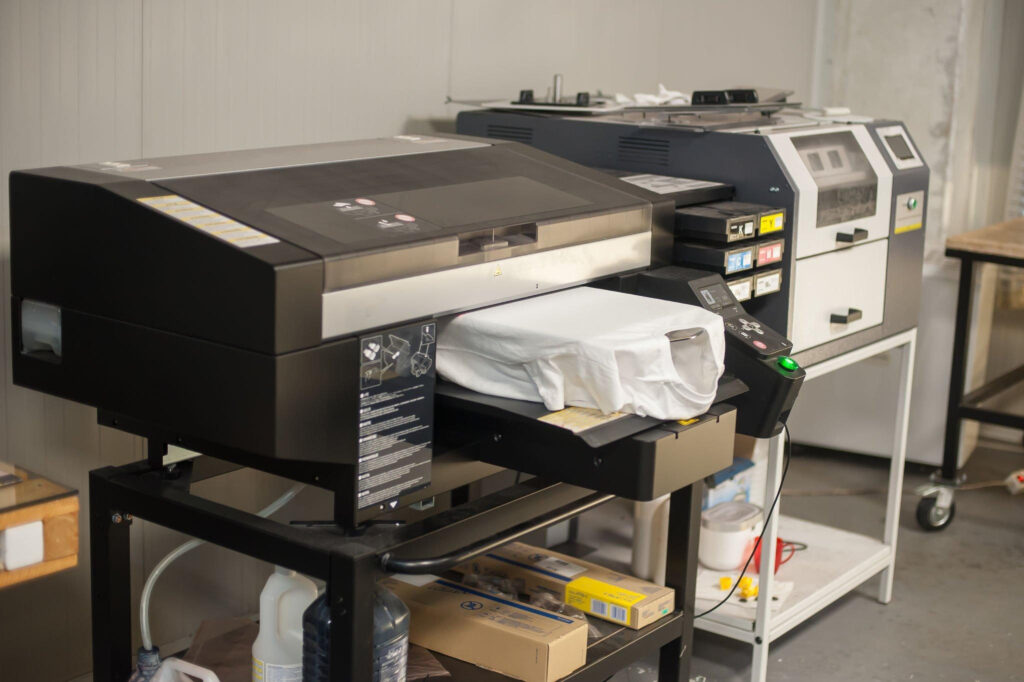Printing Services
LIST OF PRINTING TECHNIQUES
Screen Printing or Silk Screen Printing
Screen printing is the process of applying an image to a surface (typically a fabric) by forcing ink through a stencil with the desired image. Originally, the stencil was, often made of silk fabric; hence the name silk screen printing. Considered by many, the oldest method to reproduce art, screen printing remains today the most popular way to embellish custom printed apparel due to its versatility and cost effectiveness.
The setup process for screen printing can be very complex and labor intensive; due to this fact, we normally recommend a minimum of 12 to 48 prints depending on the number of colors in the design. This will improve the cost effectiveness (per print) of the job being printed.
Screen printing is a popular choice for: custom printed t-shirts for events and staff, crew uniforms, team sport uniforms and fan wear.

Instructions for Washing Screen Printed T-shirts
- Always wash your DTG printed garment before you wear it
- Wait at least 24 hours before washing your garment
- Turn your garment inside out
- Wash in cool water in a gentle cycle and use a mild detergent (hand wash for best result). Do not use bleach or fabric softeners
- Dry in a delicate setting or hang to air dry for best result
- Do not iron directly on the DTG printed image’
DTG Printing (Direct to Garment)
Direct to Garment Printing (DTG) is a specialized textile printing process that implements high-precision ink jet printers. DTG custom printing eliminates the need for the creation of stencils, as is the case with screen printing, or film transfers, because as the name implies; with DTG the image is directly printed on the garment with extremely high precision.
Direct to garment printing offers an unlimited number of colors and is usually more cost effective on small, full-color jobs than screen printing. This is an ideal printing technique for high detail prints that will never crack and never peel. Your image will; however, fade over the years and many washes just like any other natural fabric would lose its color over time because with DTG printing, the ink in impregnated in the fabric.
DTG printing is a popular choice for: Artists and graphic designers whose designs require printing images with high detail on a large array of colors, for printing designer shirts and single on-demand prints; in addition, small business owners who need only a few custom printed garments prefer this printing choice, even for single colors.
- Always wash your DTG printed garment before you wear it
- Wait at least 24 hours before washing your garment
- Turn your garment inside out
- Wash in cool water in a gentle cycle and use a mild detergent (hand wash for best result). Do not use bleach or fabric softeners
- Dry in a delicate setting or hang to air dry for best result
- Do not iron directly on the DTG printed image
Heat Transfer Printing (Vinyl Shirt Printing)
Heat transfer printing, also known as thermal printing (among other names), is a custom garment printing technique that uses a hot press to thermally transfer a pre-printed image onto a substrate. Heat transfer garment printing has a big advantage over any other type of custom garment printing, because the selection of transferrable materials is very large. For example; vinyl shirt printing, a popular choice among our clients, offers a variety of finishes; from glitter and metallic to reflective just to name a few. Due to the durability and toughness of vinyl films, vinyl shirt printing is a favorite embellishing method for sports team uniforms. Some of the transferrable materials used, also can have texture that is only available with heat transfer printing depending on the type of appliqué that is selected. Heat transfer printing, like DTG printing, also offers the ability to print full color images, with a vibrancy and sharpness that pops out of the custom printed garment.
Instructions for washing T-shirt Transfers
- Wait at least 24 hours before washing your garment
- Turn your garment inside out
- Wash in cool water in a gentle cycle and use a mild detergent (hand wash for best result). Do not use bleach or fabric softeners
- Dry in a delicate setting or hang to air-dry for best result
- Do not iron directly on the transfer image
- Do not iron directly on the transfer printed image
Embroidered Shirts –Embroidery
Embroidery (stitch printing) is the process of adding a design to a garment by needlework, using thread. This printing technique dates back many centuries BC and still remains today as one very popular way to embellish a variety of items. Embroidery can be applied to many types of fabric in items such as: towels, blankets, scarfs. Even book covers can be embroidered using different threads or yarn. Embroidered shirts have a distinct look; the printed design stands out in a way that’s very unique to this printing technique, as the art is raised above the surface of the fabric due to the volume of the thread being added. This also adds a unique texture and vibrancy of colors that make embroidered items stand out.
Embroidered polos and hats are very popular items among our clients who prefer to have their company logos stitched on their favorite golf shirt or cap. Some of our clients opt for embroidered patches, which is usually a more cost effective alternative.
Instructions for washing embroidered shirts
- Do not soak, or allow to sit wet for an extended period of time
- Wash in cold water with a mild detergent
- Do not use chlorine bleach
- Wash in cool water in a gentle cycle (wash by hand for best result), do not wring out the embroidered area
- For best drying result; preheat the dryer prior to loading your garment
- Do not iron directly on the embroidered area

